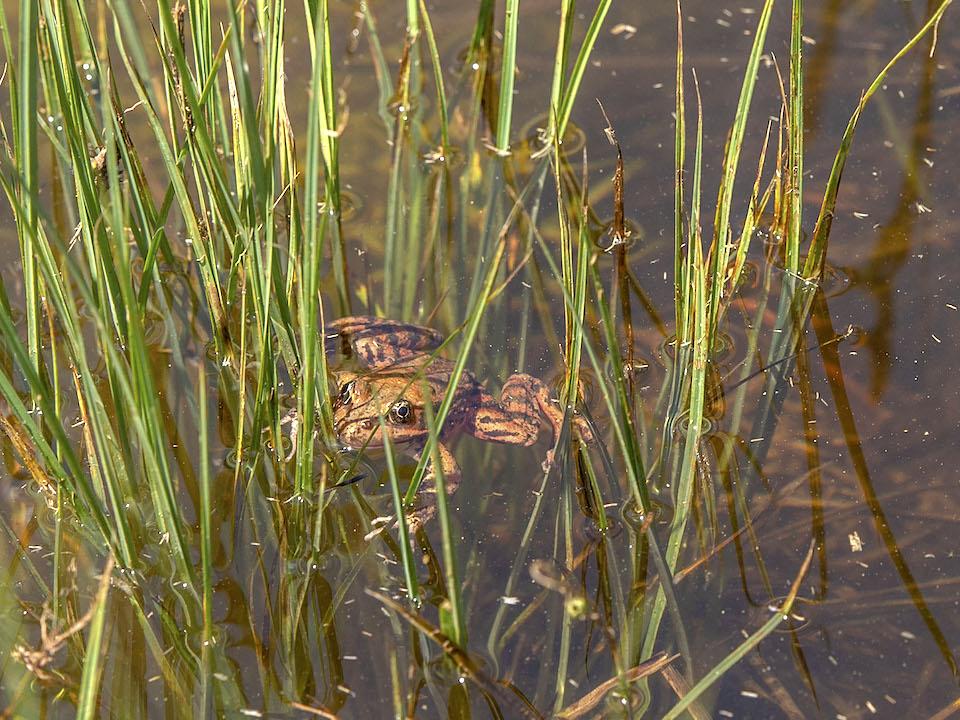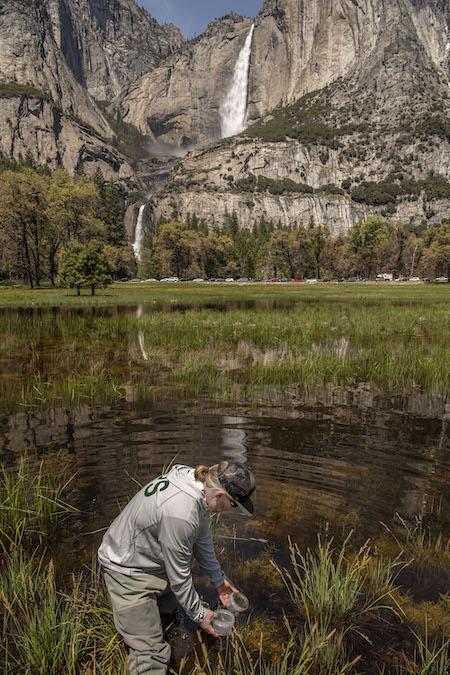
Closeup of Red-legged frog in Yosemite National Park/Yosemite Conservancy, Al Golub
A long-running project to see California red-legged frogs return to the Yosemite Valley is making strides this spring, with the sightings of some of the frogs' eggs in ponds and meadows in the valley. It marked the first documented breeding activity of the amphibians since some adult red-legged frogs were released in the valley two years ago.
The return of the frogs, which are listed as a threatened species under the Endangered Species Act, marks their return to Yosemite Valley following a 50-year absence. Their recovery is due to a collaborative effort by the National Park Service, Yosemite Conservancy, the San Francisco Zoo & Gardens, U.S. Fish & Wildlife Service, California Department of Fish & Wildlife, and NatureBridge.
“It’s unusual to find eggs in any location, and to find them this soon is a strong indication that red-legged frogs are adapting successfully to the riparian areas where we reintroduced them,” said Yosemite National Park Superintendent Mike Reynolds. “This is a major milestone in our work to reestablish a species that contributes to a healthy park ecosystem.”
The red-legged frog had not been seen in Yosemite National Park in a half-century. So far, the program, which began in 2016, has reintroduced an estimated 4,000 California red-legged frog eggs and tadpoles and 500 adult frogs.
Last week, about 200 more adult frogs were released in Yosemite Valley and another 275 will be released in June. The adults were reared at a special San Francisco Zoo facility. For the first time, this summer 75 red-legged frogs will be fitted with radio transmitters to better understand their behavior and habitats to determine the best locations for future reintroductions.
“Despite Yosemite’s popularity, it is also an important wildlife sanctuary. Protecting vulnerable species like red-legged frogs maintains the park’s biodiversity as nature envisioned,” said Yosemite Conservancy President Frank Dean. “Sustained results on programs like this take patience and a multi-year commitment by donors, the park and partners.”
Over the past three years alone, Yosemite Conservancy donors contributed $570,000 to protect aquatic species in the park. The Conservancy provided $130,000 for Yosemite frog programs in 2019.

Yosemite National Park Aquatic Ecologist Rob Grasso releases a Red-Legged Frog in water in Cooks Meadow in Yosemite Valley. Yosemite Falls is seen flowing in the background/Yosemite Conservancy, Al Golub
The disappearance of the red-legged frog from Yosemite was the result of a variety of decisions made over nearly a century. The introduction of non-native, highly invasive and predatory American Bullfrogs was the most definitive cause of the red-legged frog decline. Artificially high populations of raccoons, which are predators of frogs, resulted from open refuse sites in the 1970s and severely impacted populations. Over decades, those conditions were reversed. The health of the Yosemite Valley ecosystem improved with a variety of efforts that increased the frog’s chances of survival. The invasive bullfrogs have been eradicated, open refuse sites closed, and naturally occurring river and stream bank habitat restored to allow for a successful reintroduction of the native frogs. The release of adult frogs, as opposed to frog eggs or tadpoles, also significantly increases their chances of survival.
A permanent frog-rearing facility, known as the San Francisco Zoological Society and Yosemite National Park Conservation and Recovery Facility, opened in 2016 in San Francisco. California red-legged frogs continue to be raised in a quarantined environment to accommodate the specific needs of the animals under the care of specialized staff.
“The program has been a great teaching tool and a scientific success,” said San Francisco Zoo & Gardens CEO and Executive Director Tanya Peterson. “We are honored to work hand-in-hand with the National Park Service, Yosemite Conservancy and federal and state agencies as partnerships like these help us achieve our conservation mission and ensure the environmental health of one of our world’s great natural treasures and the resurgence of a threatened species.”
“Each of the agencies involved played a critical role in the success of reestablishing the species in Yosemite Valley,” said, Jennifer Norris, Ph.D., field supervisor of the Sacramento U.S. Fish & Wildlife Office. “Species recovery is at the core of our mission and we’re looking forward to continued collaboration to ensure that the California red-legged frog thrives.”
This effort would not have been possible without the assistance of private land owner Diane Buchholz of Garden Valley, Calif., who allowed red-legged frog eggs to be collected from her property. NatureBridge, which provides hands-on environmental science programs for children and teens, has participated with the National Park Service in releasing frogs in Yosemite Valley.
The California red-legged frog was made famous by Mark Twain in his story the “Celebrated Jumping Frog of Calaveras County.” It is 2-5 inches long and is the largest native frog in the western United States. It is reddish in color on the underside of the legs and belly, and communicates with a series of short soft grunts. It is found in ponds, pools, streams and wet meadows.



Comments
Great news!